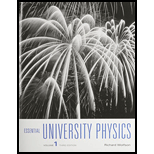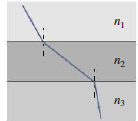
Essential University Physics (3rd Edition)
3rd Edition
ISBN: 9780134202709
Author: Richard Wolfson
Publisher: PEARSON
expand_more
expand_more
format_list_bulleted
Textbook Question
Chapter 30.2, Problem 30.2GI
The figure shows the path of a light ray through three different media. Rank the media according to their refractive indices, in decreasing order.

Expert Solution & Answer
Want to see the full answer?
Check out a sample textbook solution
Students have asked these similar questions
Close-up view
etermine;
The volume of the object given that the initial level of water in the measuring cylinder
23cm3.
The density of the object.
simple cell made by dipping copper and zinc plates into dilute sulfuric acid solution. A bull
onnected across the plates using a wire.
State what constitute current flow through the wire
The bulb connected across is observed to light for some time and then goes out. State t
possible
asons for this observation.
State two ways in which the processes named in question (b) above can be minimized t
the bulb light for a longer period.
ead
is rated 80Ah. Determine the current that can be drawn continuously
Answers with -1.828, -1.31 or 939.3 are not correct.
Three slits, each separated from its neighbor by d = 0.06 mm, are illuminated by a coherent light source of
wavelength 550 nm. The slits are extremely narrow. A screen is located L = 2.5 m from the slits. The
intensity on the centerline is 0.05 W. Consider a location on the screen x = 1.72 cm from the centerline.
a) Draw the phasors, according to the phasor model for the addition of harmonic waves, appropriate for this
location.
b) From the phasor diagram, calculate the intensity of light at this location.
Chapter 30 Solutions
Essential University Physics (3rd Edition)
Ch. 30.1 - Prob. 30.1GICh. 30.2 - The figure shows the path of a light ray through...Ch. 30.3 - The glass prism in Fig. 30.11 has n = 1.5 and is...Ch. 30.4 - Prob. 30.4GICh. 30 - Prob. 1FTDCh. 30 - Why does a spoon appear bent when its in a glass...Ch. 30 - Prob. 3FTDCh. 30 - Prob. 4FTDCh. 30 - You send white light through two identical glass...Ch. 30 - Prob. 6FTD
Ch. 30 - Prob. 7FTDCh. 30 - Why are polarizing sunglasses better than glasses...Ch. 30 - Under what conditions will the polarizing angle be...Ch. 30 - Through what angle should you rotate a mirror so...Ch. 30 - Prob. 12ECh. 30 - To what angular accuracy must two ostensibly...Ch. 30 - Prob. 14ECh. 30 - In which substance in Table 30.1 does the speed of...Ch. 30 - Information in a compact disc is stored in pits"...Ch. 30 - Light is incident on an air-glass interface, and...Ch. 30 - A light ray propagates in a transparent material...Ch. 30 - Light propagating in the glass (n = 1.52) wall of...Ch. 30 - Prob. 20ECh. 30 - Find the refractive index of a material for which...Ch. 30 - Prob. 22ECh. 30 - Prob. 23ECh. 30 - What is the critical angle for light propagating...Ch. 30 - Prob. 25ECh. 30 - Blue and red laser beams strike an air-glass...Ch. 30 - White light propagating in air is incident at 45...Ch. 30 - Suppose the 60 angle in Fig. 30.18 is changed to...Ch. 30 - The refractive index of a human cornea is 1.40. If...Ch. 30 - Two plane mirrors make an angle . A light ray...Ch. 30 - An unlabeled bottle of liquid has spilled, and...Ch. 30 - A meter stick lies on the bottom of the...Ch. 30 - Prob. 33PCh. 30 - At the aquarium where you work, a fish has gone...Ch. 30 - Prob. 35PCh. 30 - You've dropped your car keys at night off the end...Ch. 30 - Laser eye surgery uses ultraviolet light with...Ch. 30 - Prob. 38PCh. 30 - Repeat Problem 38 for the case n = 1.75, = 40,...Ch. 30 - Find the minimum refractive index for the prism in...Ch. 30 - Where and in what direction would the main beam...Ch. 30 - Find the speed of light in a material for which...Ch. 30 - Prob. 43PCh. 30 - For the interface between air (refractive index 1)...Ch. 30 - A scuba diver sets off a camera flash at depth h...Ch. 30 - Suppose the red and blue beams of Exercise 26 are...Ch. 30 - In cataract surgery, ophthalmologists replace the...Ch. 30 - In a ruby laser, light is produced in a solid rod...Ch. 30 - Reconsider Example 30.4, now in a glass with n700...Ch. 30 - A cylindrical tank 2.4 m deep is full to the brim...Ch. 30 - For what diameter tank in Problem 50 will sunlight...Ch. 30 - Light is incident from air on the flat wall of a...Ch. 30 - Prob. 53PCh. 30 - Find an expression for the displacement x in Fig....Ch. 30 - Prob. 55PCh. 30 - (a) Differentiate the result of Problem 55 to show...Ch. 30 - Prob. 57PCh. 30 - Prob. 58PCh. 30 - Fermat's principle states that a light ray's path...Ch. 30 - Prob. 60PCh. 30 - A slab of transparent material has thickness d and...Ch. 30 - For common materials like glass, the wavelength...Ch. 30 - Figure 30.25a depicts lights path over a hot road,...Ch. 30 - Prob. 64PPCh. 30 - Figure 30.25b shows how continuous refraction in...Ch. 30 - The refractive index in the ionosphere is strongly...
Additional Science Textbook Solutions
Find more solutions based on key concepts
Match the following examples of mutagens. Column A Column B ___a. A mutagen that is incorporated into DNA in pl...
Microbiology: An Introduction
1.3 Obtain a bottle of multivitamins and read the list of ingredients. What are four chemicals from the list?
Chemistry: An Introduction to General, Organic, and Biological Chemistry (13th Edition)
Two culture media were inoculated with four different bacteria. After incubation, the following results were ob...
Microbiology: An Introduction
Use the key to classify each of the following described tissue types into one of the four major tissue categori...
Anatomy & Physiology (6th Edition)
Where are skeletal cartilages located?
Human Anatomy & Physiology (2nd Edition)
Q1. What is the empirical formula of a compound with the molecular formula
Chemistry: A Molecular Approach (4th Edition)
Knowledge Booster
Learn more about
Need a deep-dive on the concept behind this application? Look no further. Learn more about this topic, physics and related others by exploring similar questions and additional content below.Similar questions
- A Jamin interferometer is a device for measuring or for comparing the indices of refraction of gases. A beam of monochromatic light is split into two parts, each of which is directed along the axis of a separate cylindrical tube before being recombined into a single beam that is viewed through a telescope. Suppose we are given the following, • Length of each tube is L = 0.4 m. • λ= 598 nm. Both tubes are initially evacuated, and constructive interference is observed in the center of the field of view. As air is slowly let into one of the tubes, the central field of view changes dark and back to bright a total of 198 times. (a) What is the index of refraction for air? (b) If the fringes can be counted to ±0.25 fringe, where one fringe is equivalent to one complete cycle of intensity variation at the center of the field of view, to what accuracy can the index of refraction of air be determined by this experiment?arrow_forward1. An arrangement of three charges is shown below where q₁ = 1.6 × 10-19 C, q2 = -1.6×10-19 C, and q3 3.2 x 10-19 C. 2 cm Y 93 92 91 X 3 cm (a) Calculate the magnitude and direction of the net force on q₁. (b) Sketch the direction of the forces on qiarrow_forward(Figure 1)In each case let w be the weight of the suspended crate full of priceless art objects. The strut is uniform and also has weight w Find the direction of the force exerted on the strut by the pivot in the arrangement (a). Express your answer in degrees. Find the tension Tb in the cable in the arrangement (b). Express your answer in terms of w. Find the magnitude of the force exerted on the strut by the pivot in the arrangement (b). Express your answer in terms of w.arrow_forward
- (Figure 1)In each case let ww be the weight of the suspended crate full of priceless art objects. The strut is uniform and also has weight w. Find the direction of the force exerted on the strut by the pivot in the arrangement (b). Express your answer in degrees.arrow_forwardA 70.0 cm, uniform, 40.0 N shelf is supported horizontally by two vertical wires attached to the sloping ceiling (Figure 1). A very small 20.0 N tool is placed on the shelf midway between the points where the wires are attached to it. Find the tension in the left-hand wire. Express your answer with the appropriate units.arrow_forwardFind the total bind Mev. binding energy for 13 Carbon, 6C (atomic mass = 13.0033554)arrow_forward
- What is the 27 energy absorbed in this endothermic Auclear reaction 2] Al + 'n → 27 Mg + ! H? (The atom mass of "Al is 26.981539u. and that of 11 Mg is 26.984341u) MeVarrow_forwardWhat is the energy released in this nuclear reaction 1 F + "', H-1 O+ He? 19 19 16 (The atomic mass of 1F is 18.998403 u, and that of 20 is 15.9949154) MeV.arrow_forwardWhat is the energy released in this B+ nuclear reaction خالد 2½ Al w/ Mg + ie? (The atomic mass of 11 Al is 23.9999394 and that > of 12 Mg is 23.985041 u) MeV.arrow_forward
- What is the energy released / absorbed in this nuclear reaction 14 N+ & He → » O + ! N? (The atomic mass of 14 N is 14.003074u. 17N+ and that of 10 is 16.9991324). MeVarrow_forwardCan someone help me answer this question thanks.arrow_forwardCan someone help me with this question thanks.arrow_forward
arrow_back_ios
SEE MORE QUESTIONS
arrow_forward_ios
Recommended textbooks for you
 Principles of Physics: A Calculus-Based TextPhysicsISBN:9781133104261Author:Raymond A. Serway, John W. JewettPublisher:Cengage Learning
Principles of Physics: A Calculus-Based TextPhysicsISBN:9781133104261Author:Raymond A. Serway, John W. JewettPublisher:Cengage Learning An Introduction to Physical SciencePhysicsISBN:9781305079137Author:James Shipman, Jerry D. Wilson, Charles A. Higgins, Omar TorresPublisher:Cengage Learning
An Introduction to Physical SciencePhysicsISBN:9781305079137Author:James Shipman, Jerry D. Wilson, Charles A. Higgins, Omar TorresPublisher:Cengage Learning Physics for Scientists and Engineers: Foundations...PhysicsISBN:9781133939146Author:Katz, Debora M.Publisher:Cengage Learning
Physics for Scientists and Engineers: Foundations...PhysicsISBN:9781133939146Author:Katz, Debora M.Publisher:Cengage Learning Glencoe Physics: Principles and Problems, Student...PhysicsISBN:9780078807213Author:Paul W. ZitzewitzPublisher:Glencoe/McGraw-Hill
Glencoe Physics: Principles and Problems, Student...PhysicsISBN:9780078807213Author:Paul W. ZitzewitzPublisher:Glencoe/McGraw-Hill College PhysicsPhysicsISBN:9781305952300Author:Raymond A. Serway, Chris VuillePublisher:Cengage Learning
College PhysicsPhysicsISBN:9781305952300Author:Raymond A. Serway, Chris VuillePublisher:Cengage Learning Physics for Scientists and EngineersPhysicsISBN:9781337553278Author:Raymond A. Serway, John W. JewettPublisher:Cengage Learning
Physics for Scientists and EngineersPhysicsISBN:9781337553278Author:Raymond A. Serway, John W. JewettPublisher:Cengage Learning

Principles of Physics: A Calculus-Based Text
Physics
ISBN:9781133104261
Author:Raymond A. Serway, John W. Jewett
Publisher:Cengage Learning

An Introduction to Physical Science
Physics
ISBN:9781305079137
Author:James Shipman, Jerry D. Wilson, Charles A. Higgins, Omar Torres
Publisher:Cengage Learning

Physics for Scientists and Engineers: Foundations...
Physics
ISBN:9781133939146
Author:Katz, Debora M.
Publisher:Cengage Learning

Glencoe Physics: Principles and Problems, Student...
Physics
ISBN:9780078807213
Author:Paul W. Zitzewitz
Publisher:Glencoe/McGraw-Hill

College Physics
Physics
ISBN:9781305952300
Author:Raymond A. Serway, Chris Vuille
Publisher:Cengage Learning

Physics for Scientists and Engineers
Physics
ISBN:9781337553278
Author:Raymond A. Serway, John W. Jewett
Publisher:Cengage Learning
Polarization of Light: circularly polarized, linearly polarized, unpolarized light.; Author: Physics Videos by Eugene Khutoryansky;https://www.youtube.com/watch?v=8YkfEft4p-w;License: Standard YouTube License, CC-BY